Structure Function Analysis of Temperature-Dependent Thermal Properties of Nm-Thin Nb2O5
Abstract
1. Introduction
2. Materials and Methods
2.1. Time Domain Thermoreflectance
2.2. Finite Volume Simulation
2.3. Theoretical Background
2.3.1. Structure Function for Dirac-Delta Function Excitation (NanoTR)
2.3.2. Structure Function for Cycled Pulsed Excitation (PicoTR)
3. Results
3.1. Analytical Solution of Fourier’s Law to Evaluate Thermal Diffusivity
3.2. Structure Function to Analyse the Heat Path in Nb2O5
3.2.1. Structure Function for Delta Function Excitation of Nanosecond Thermal Transients
3.2.2. Structure Function for Pulsed Cycled Excitation of Picosecond Thermal Transients
4. Discussion
5. Conclusions
Author Contributions
Funding
Acknowledgments
Conflicts of Interest
Appendix A

References
- Jones, R.E.; Duda, J.C.; Zhou, X.W.; Kimmer, C.J.; Hopkins, P.E. Investigation of size and electronic effects on Kapitza conductance with non-equilibrium molecular dynamics. Appl. Phys. Lett. 2013, 102, 183119. [Google Scholar] [CrossRef]
- Coşkun, Ö.D.; Demirel, S.; Atak, G. The effects of heat treatment on optical, structural, electrochromic and bonding properties of Nb2O5 thin films. J. Alloys Compd. 2015, 648, 994–1004. [Google Scholar] [CrossRef]
- Lorenz, R.; O’Sullivan, M.; Fian, A.; Sprenger, D.; Lang, B.; Mitterer, C. A comparative study on NbOx films reactively sputtered from sintered and cold gas sprayed targets. Appl. Surf. Sci. 2018, 436, 1157–1162. [Google Scholar] [CrossRef]
- Magnien, J.; Mitterhuber, L.; Rosc, J.; Schrank, F.; Hörth, S.; Goullon, L.; Hutter, M.; Defregger, S.; Kraker, E. Reliability and failure analysis of solder joints in flip chip LEDs via thermal impedance characterisation. Microelectron. Reliab. 2017, 76–77, 601–605. [Google Scholar] [CrossRef]
- Taketoshi, N.; Baba, T.; Ono, A. Development of a thermal diffusivity measurement system for metal thin films using a picosecond thermoreflectance technique. Meas. Sci. Technol. 2001, 12, 2064–2073. [Google Scholar] [CrossRef]
- Székely, V.; Van Bien, T. Fine Structure of Heat Flow Path in Semiconductor Devices: A Measurement and Identification Method. Solid. State. Electron. 1988, 31, 1363–1368. [Google Scholar] [CrossRef]
- Rencz, M.; Poppe, A.; Ress, S. A Procedure to Correct the Error in the Structure Function Based Thermal Measuring Methods. In Proceedings of the Twentieth Annual IEEE Semiconductor Thermal Measurement and Management Symposium, San Jose, CA, USA, 11 March 2004. [Google Scholar]
- Rencz, M.; Székely, V.; Morelli, A.; Villa, C. Determining Partial Thermal Resistances with Transient Measurements, and Using the Method to Detect Die Attach Discontinuities. In Proceedings of the Eighteenth Annual IEEE Semiconductor Thermal Measurement and Management Symposium, San Jose, CA, USA, 12–14 March 2002; pp. 15–20. [Google Scholar]
- Mitterhuber, L.; Defregger, S.; Hammer, R.; Magnien, J.; Schrank, F.; Hörth, S.; Hutter, M.; Kraker, E. Validation methodology to analyze the temperature-dependent heat path of a 4-chip LED module using a finite volume simulation. Microelectron. Reliab. 2017, 79, 462–472. [Google Scholar] [CrossRef]
- Netzsch (Ed.) Thermoreflectance by Pulsed Light Heating Thermoreflectance—NanoTR/PicoTR. Available online: https://www.netzsch-thermal-analysis.com/media/thermal.../Thermoreflectance.pdf (accessed on 14 February 2019).
- Wilson, R.B.; Apgar, B.A.; Martin, L.W.; Cahill, D.G. Thermoreflectance of metal transducers for optical pump-probe studies of thermal properties. Opt. Express 2012, 20, 28829–28838. [Google Scholar] [CrossRef]
- Werner, W.S.M.; Glantschnig, K.; Ambrosch-Draxl, C. Optical constants and inelastic electron-scattering data for 17 elemental metals. J. Phys. Chem. Ref. Data 2009, 38, 1013–1092. [Google Scholar] [CrossRef]
- Hopkins, P.E.; Serrano, J.R.; Phinney, L.M.; Kearney, S.P.; Grasser, T.W.; Harris, C.T. Criteria for Cross-Plane Dominated Thermal Transport in Multilayer Thin Film Systems During Modulated Laser Heating. J. Heat Transf. 2010, 132, 081302. [Google Scholar] [CrossRef]
- Chen, H.; Lu, Y.; Gao, Y.; Zhang, H.; Chen, Z. The performance of compact thermal models for LED package. Thermochim. Acta 2009, 488, 33–38. [Google Scholar] [CrossRef]
- Székely, V.; Szalai, A. Measurement of the time-constant spectrum: Systematic errors, correction. Microelectron. J. 2012, 43, 904–907. [Google Scholar] [CrossRef]
- Székely, V.; Rencz, M.M. Increasing the Accuracy of Thermal Transient Measurements. IEEE Trans. Compon. Packag. Technol. 2002, 25, 539–546. [Google Scholar] [CrossRef]
- Ezzahri, Y.; Shakouri, A. Application of network identification by deconvolution method to the thermal analysis of the pump-probe transient thermoreflectance signal. Rev. Sci. Instrum. 2009, 80, 074903. [Google Scholar] [CrossRef] [PubMed]
- Russo, S. Measurement and Simulation of Electrothermal Effects in Solid-State Devices for RF Applications. Ph.D. Thesis, Universita Degli Studi di Napoli Ferderico II, Napoli, Italy, 2010. [Google Scholar]
- Glavanovics, M.; Zitta, H. Thermal Destruction Testing: An Indirect Approach to a Simple Dynamic Thermal Model of Smart Power Switches. In Proceedings of the 27th European Solid-State Circuits Conference, Villach, Austria, 18–20 September 2001; Volume 2. [Google Scholar]
- Székely, V. A new evaluation method of thermal transient measurement results. Microelectron. J. 1997, 28, 277–292. [Google Scholar] [CrossRef]
- Jakopovid, Z.; Bencic, Z.; Koncar, R.; Jakopovid, R.K.Z.; Bencic, Z. Identification of thermal equivalent-circuit parameters for semiconductors. In Proceedings of the 1990 IEEE Workshop on Computers in Power Electronics, Lewisburg, PA, USA, 5–7 August 1990; pp. 251–260. [Google Scholar]
- Masana, F.N. A straightforward analytical method for extraction of semiconductor device transient thermal parameters. Microelectron. Reliab. 2007, 47, 2122–2128. [Google Scholar] [CrossRef]
- Stout, R.P. How to Generate Square Wave, Constant Duty Cycle, Transient Response Curves; Semiconductor Component Industries, LLC: Phoenix, AZ, USA, 2006. [Google Scholar]
- Székely, V.; Rencz, M. Thermal Dynamics and the Time Constant Domain. IEEE Trans. Compon. Packag. Technol. 2000, 23, 587–594. [Google Scholar] [CrossRef]
- Norris, P.M.; Caffrey, A.P.; Stevens, R.J.; Klopf, J.M.; McLeskey, J.T.; Smith, A.N. Femtosecond pump-probe nondestructive examination of materials (invited). Rev. Sci. Instrum. 2003, 74, 400–406. [Google Scholar] [CrossRef]
- Douglass, D.L. The thermal expansion of niobium pentoxide and its effect on the spalling of niobium oxidation films. J. Less-Common Met. 1963, 5, 151–157. [Google Scholar] [CrossRef]
- Laubitz, M.J.; van der Meer, M.P. The thermal conductivity of platinum between 300 and 1000 K. Can. J. Phys. 1966, 44, 3173–3183. [Google Scholar] [CrossRef]
- Nakamura, F.; Taketoshi, N.; Yagi, T.; Baba, T. Observation of thermal transfer across a Pt thin film at a low temperature using a femtosecond light pulse thermoreflectance method. Meas. Sci. Technol. 2011, 22, 024013. [Google Scholar] [CrossRef]
- Engineering ToolBox. Coefficients of Linear Thermal Expansion. 2003. Available online: https://www.engineeringtoolbox.com/linear-expansion-coefficients-d_95.html (accessed on 21 November 2018).
- Ho, C.Y.; Powell, R.W.; Liley, P.E. Thermal conductivity of the Elements. J. Phys. Chem. Ref. Data 1972, 1, 279–421. [Google Scholar] [CrossRef]
- Endo, R.K.; Fujihara, Y.; Susa, M. Calculation of the density and heat capacity of silicon by molecular dynamics simulation. High Temp. High Press. 2003, 35–36, 505–511. [Google Scholar] [CrossRef]
- Chase, M.W. NIST-JANAF Thermochemical Tables 2 Volume-Set (Journal of Physical and Chemical Reference Data Monographs); American Institute of Physics: College Park, MD, USA, 1998. [Google Scholar]
- Cheng, Z.; Weidenbach, A.; Feng, T.; Tellekamp, M.B.; Howard, S.; Wahila, M.J.; Zivasatienraj, B.; Foley, B.; Pantelides, S.T.; Piper, L.F.; et al. Diffuson-driven Ultralow Thermal Conductivity in Amorphous Nb2O5 Thin Films. arXiv, 2018; arXiv:1807.05483. [Google Scholar]
- Björck, M.; Andersson, G. GenX: An extensible X-ray reflectivity refinement program utilizing differential evolution. J. Appl. Crystallogr. 2007, 40, 1174–1178. [Google Scholar] [CrossRef]
- Cahill, D.G.; Watson, S.K.; Pohl, R.O. Lower limit to the thermal conductivity of disordered crystals. Phys. Rev. B 1992, 46, 6131–6140. [Google Scholar] [CrossRef]
- Bai, S.; Tang, Z.; Huang, Z.; Yu, J. Thermal Characterization of Si3N4 Thin Films Using Transient Thermoreflectance Technique. IEEE Trans. Ind. Electron. 2009, 56, 3238–3243. [Google Scholar]
- Chien, H.C.; Yao, D.J.; Hsu, C.T. Measurement and evaluation of the interfacial thermal resistance between a metal and a dielectric. Appl. Phys. Lett. 2008, 93, 12–15. [Google Scholar] [CrossRef]
- Nath, P.; Chopra, K.L. Thermal conductivity of amorphous vs. crystalline Ge and GeTe films. Jpn. J. Appl. Phys. 1974, 13, 781–784. [Google Scholar] [CrossRef]
- Cahill, D.G. Thermal conductivity measurement from 30 to 750 K: The 3omega method. Rev. Sci. Instrum. 1990, 61, 802–808. [Google Scholar] [CrossRef]
- Gaillac, R.; Pullumbi, P.; Coudert, F.-X. ELATE: An open-source online application for analysis and visualization of elastic tensors. J. Phys. Condens. Matter 2016, 28, 275201. [Google Scholar] [CrossRef]
- Shcherbina, O.B.; Palatnikov, M.N.; Efremov, V.V. Mechanical properties of Nb2O5 and Ta2O5 prepared by different procedures. Inorg. Mater. 2012, 48, 433–438. [Google Scholar] [CrossRef]
- Savitzky, A.; Golay, M.J.E. Smoothing and Differentiation of Data by Simplified Least Squares Procedures. Anal. Chem. 1964, 36, 1627–1639. [Google Scholar] [CrossRef]
- Ezzahri, Y.; Pernot, G.; Joulain, K.; Shakouri, A. Capturing the Cumulative Effect in the Pump Probe Transient Thermoreflectance Technique using Network Identification by Deconvolution Method. Mater. Res. Soc. Symp. Proc. 2011, 1347, 26–33. [Google Scholar] [CrossRef]
- Dilhaire, S.; Rampnoux, J.-M.; Grauby, S.; Pernot, G.; Calbris, G. Nanoscale Thermal Transport Studied With Heterodyne Picosecond Thermoreflectance. In Proceedings of the ASME 2009 Second International Conference on Micro/Nanoscale Heat and Mass Transfer, Shanghai, China, 18–21 December 2009; pp. 451–456. [Google Scholar]
- Dilhaire, S.; Pernot, G.; Calbris, G.; Rampnoux, J.M.; Grauby, S. Heterodyne picosecond thermoreflectance applied to nanoscale thermal metrology. J. Appl. Phys. 2011, 110, 114314. [Google Scholar] [CrossRef]
- Yagi, T.; Tamano, K.; Sato, Y.; Taketoshi, N.; Baba, T.; Shigesato, Y. Analysis on thermal properties of tin doped indium oxide films by picosecond thermoreflectance measurement. J. Vac. Sci. Technol. A Vac. Surf. Film 2005, 23, 1180–1186. [Google Scholar] [CrossRef]
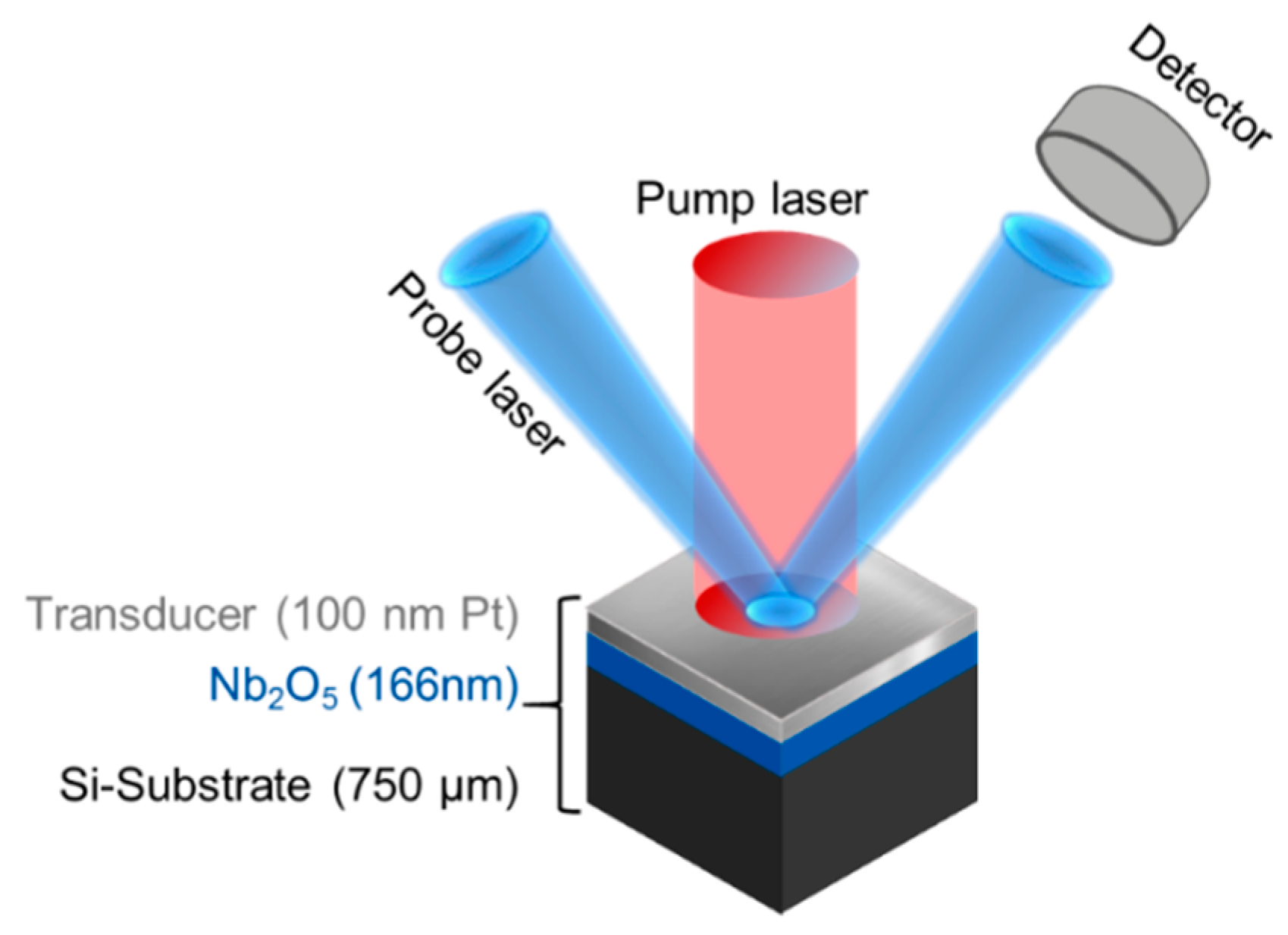
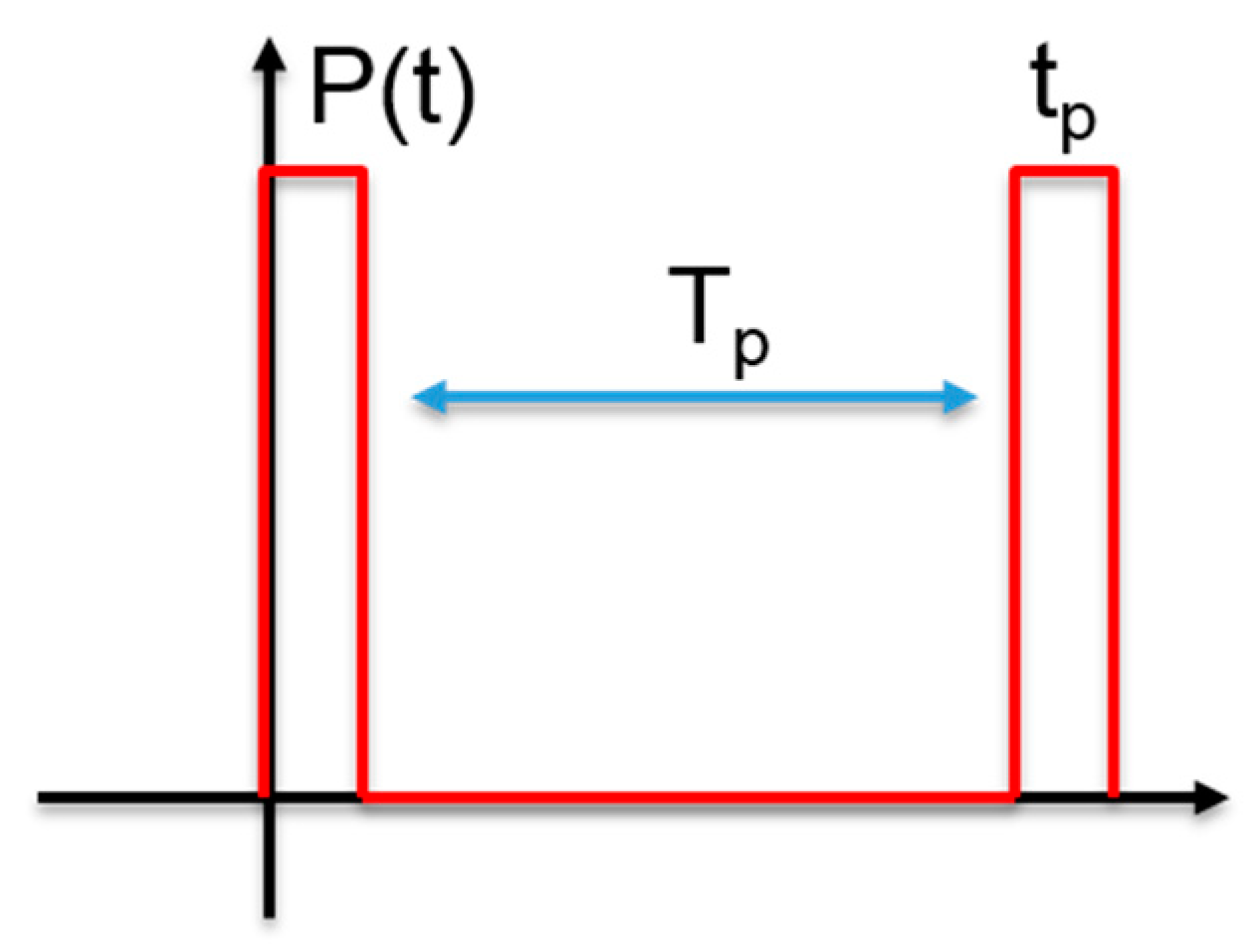

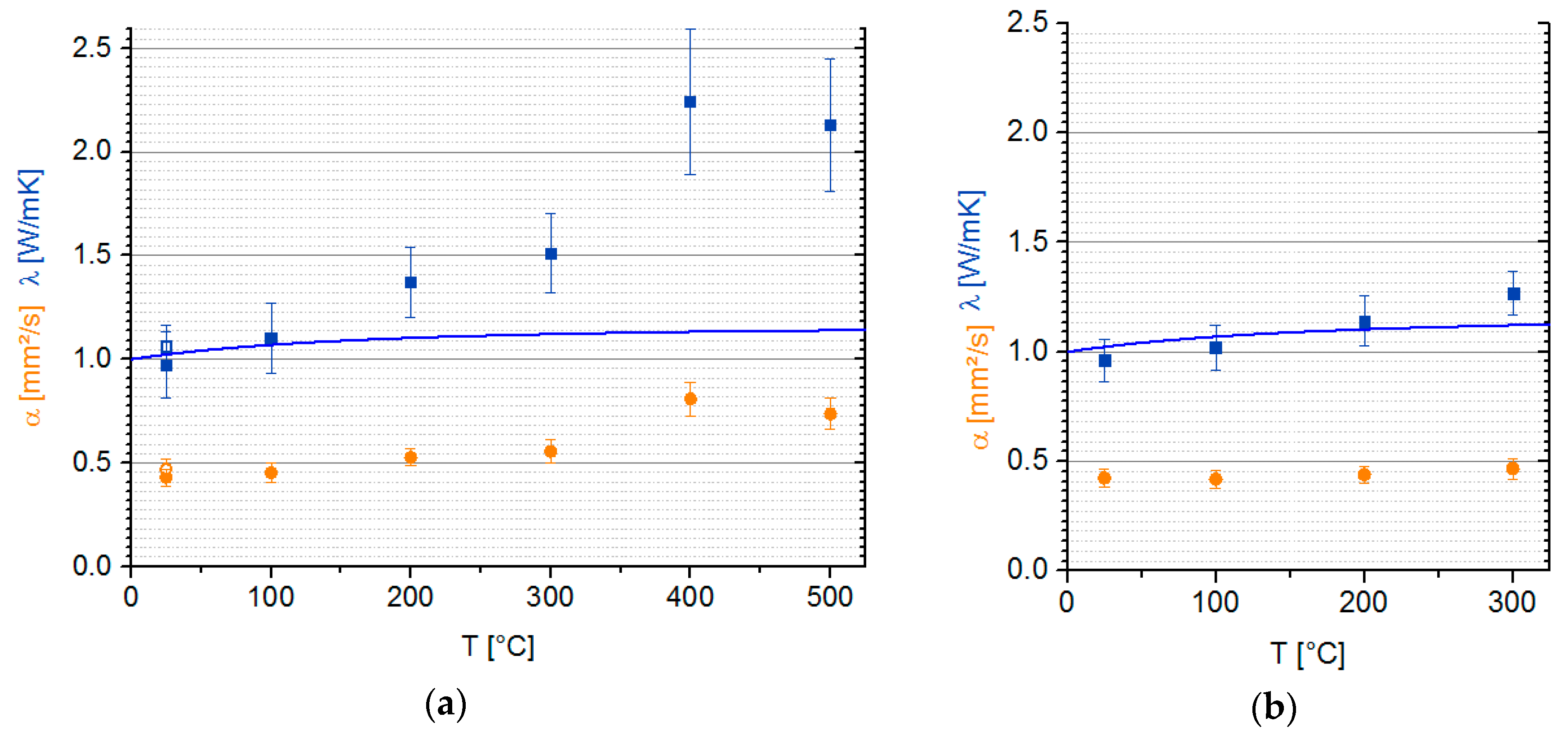
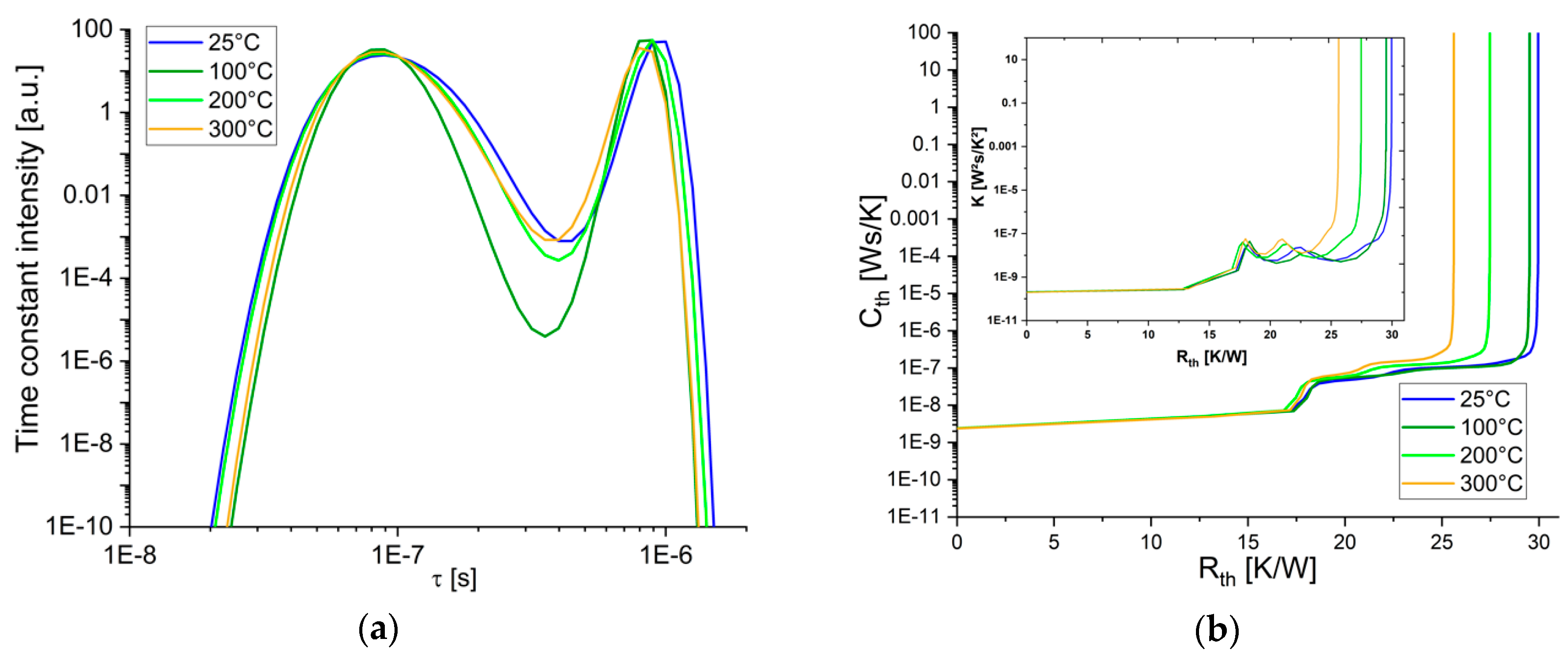
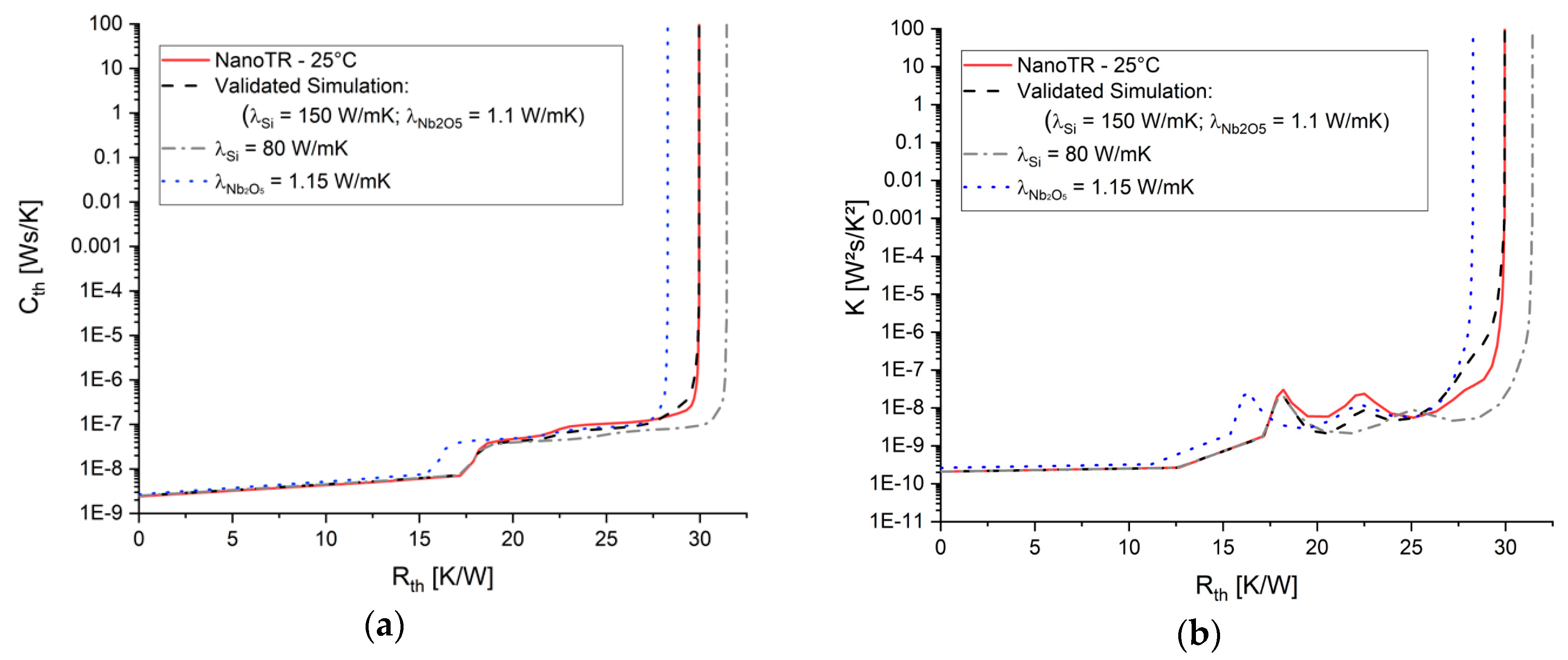
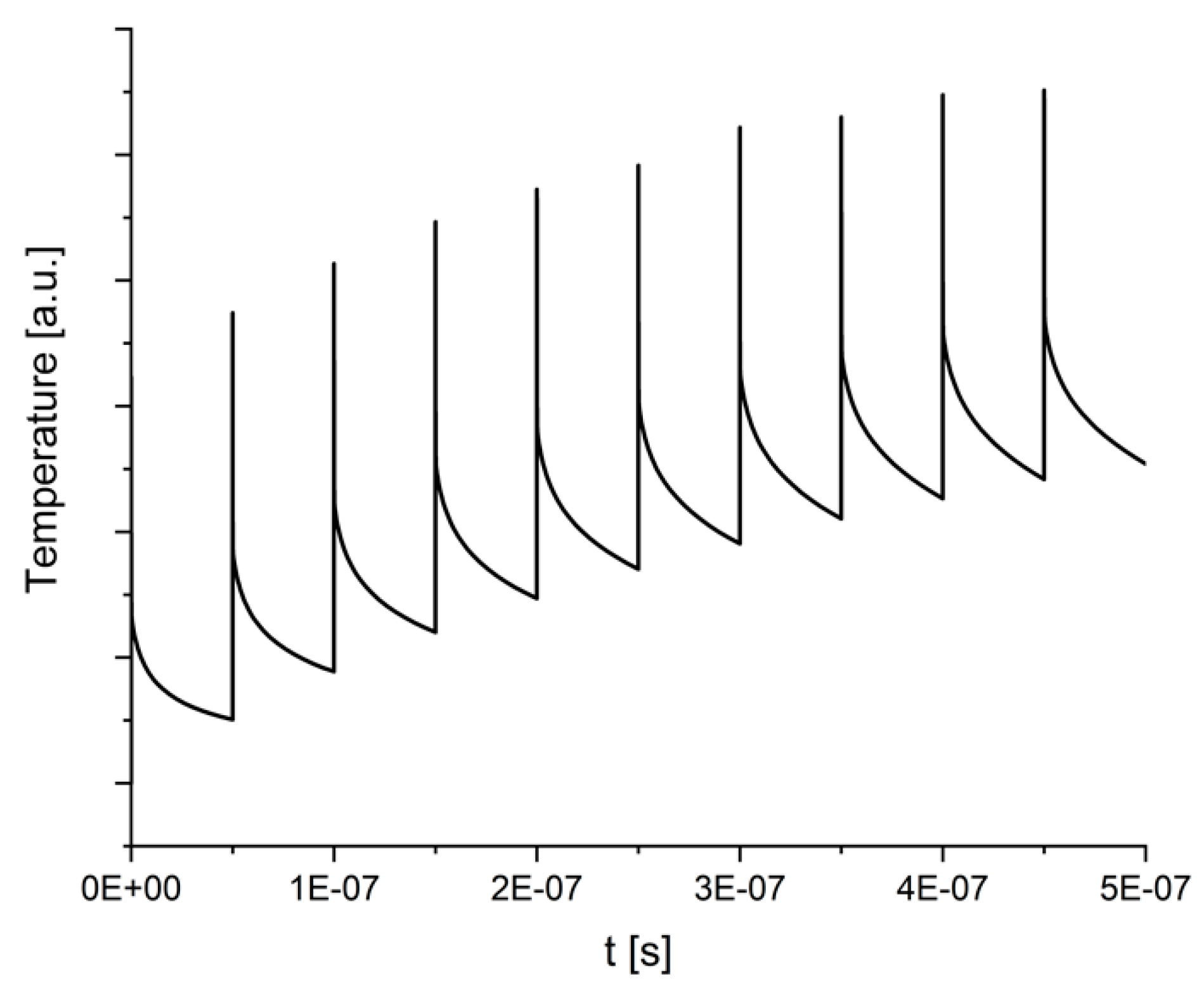
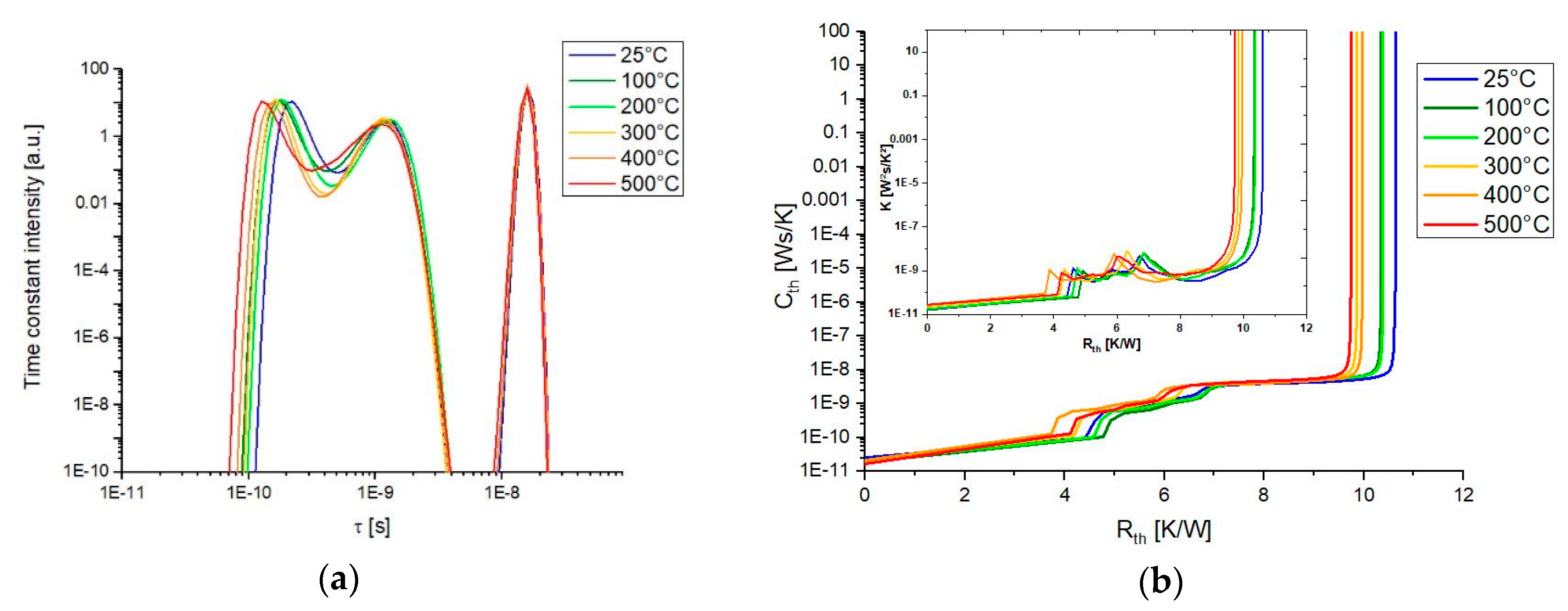
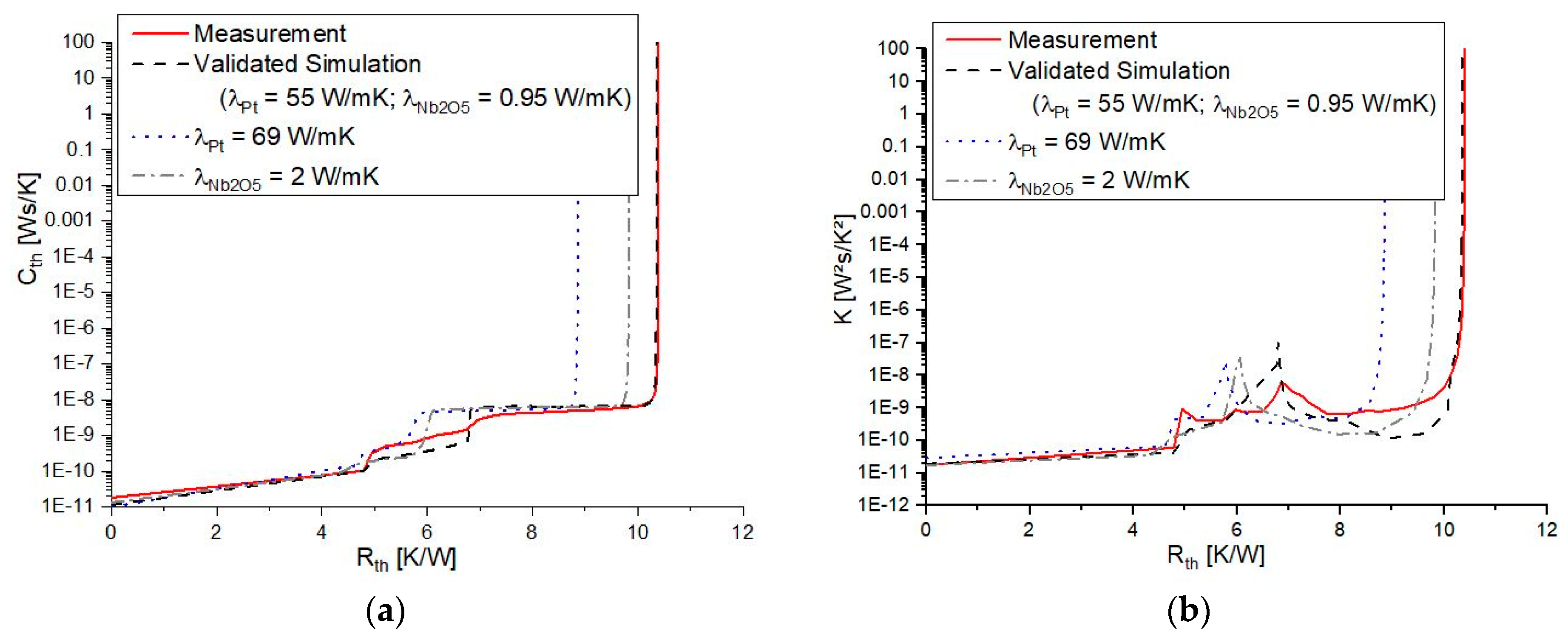
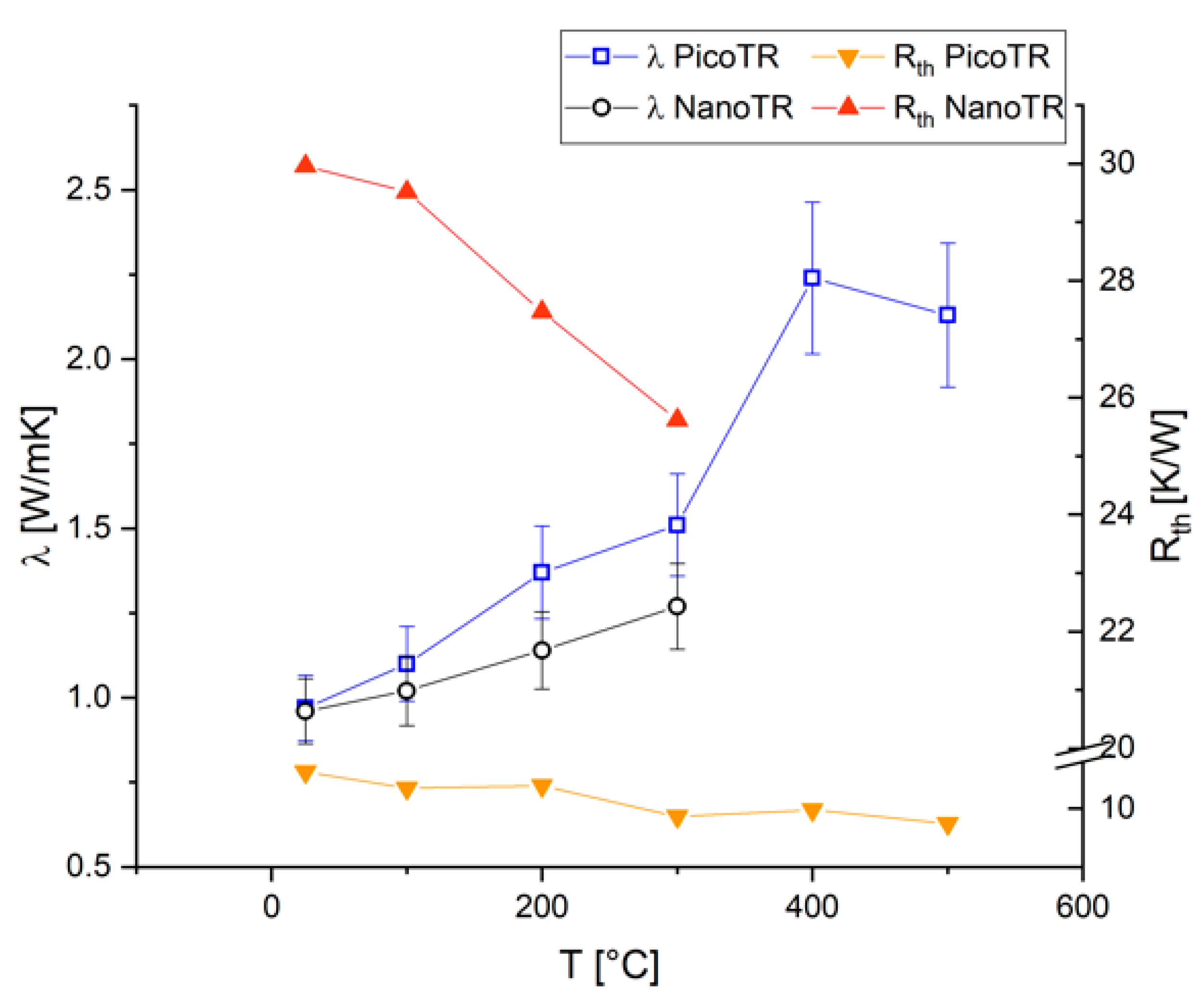
| λPump (nm) | λProbe (nm) | PPump (mW) | ØPump (µm) | ØProbe (µm) | tp (s) | Tp (s) | |
|---|---|---|---|---|---|---|---|
| PicoTR | 1550 | 775 | 25 | 45 | 25 | 5 × 10−13 | 5 × 10−8 |
| NanoTR | 1550 | 775 | 25 | 100 | 50 | 1 × 10−9 | 2 × 10−5 |
© 2019 by the authors. Licensee MDPI, Basel, Switzerland. This article is an open access article distributed under the terms and conditions of the Creative Commons Attribution (CC BY) license (http://creativecommons.org/licenses/by/4.0/).
Share and Cite
Mitterhuber, L.; Kraker, E.; Defregger, S. Structure Function Analysis of Temperature-Dependent Thermal Properties of Nm-Thin Nb2O5. Energies 2019, 12, 610. https://doi.org/10.3390/en12040610
Mitterhuber L, Kraker E, Defregger S. Structure Function Analysis of Temperature-Dependent Thermal Properties of Nm-Thin Nb2O5. Energies. 2019; 12(4):610. https://doi.org/10.3390/en12040610
Chicago/Turabian StyleMitterhuber, Lisa, Elke Kraker, and Stefan Defregger. 2019. "Structure Function Analysis of Temperature-Dependent Thermal Properties of Nm-Thin Nb2O5" Energies 12, no. 4: 610. https://doi.org/10.3390/en12040610
APA StyleMitterhuber, L., Kraker, E., & Defregger, S. (2019). Structure Function Analysis of Temperature-Dependent Thermal Properties of Nm-Thin Nb2O5. Energies, 12(4), 610. https://doi.org/10.3390/en12040610





